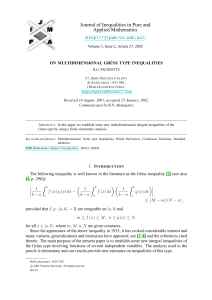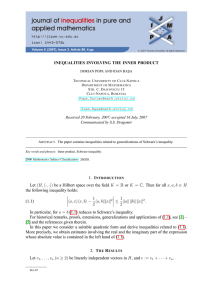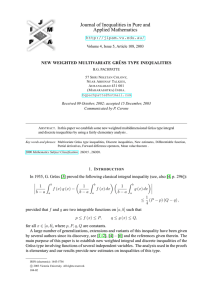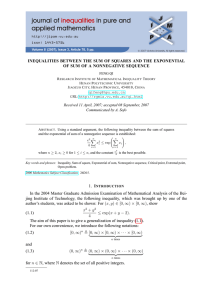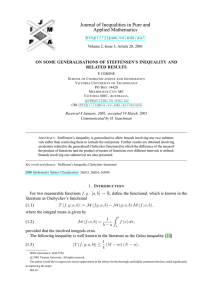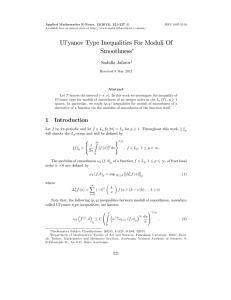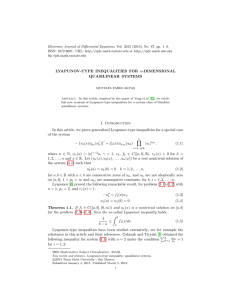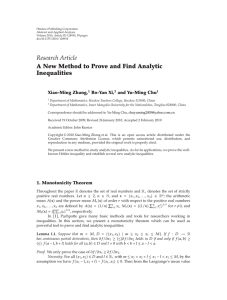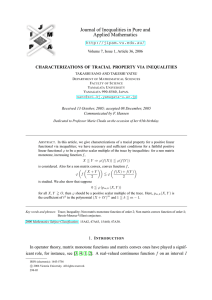TWO MAPPINGS RELATED TO MINKOWSKI’S INEQUALITIES XIU-FEN MA AND LIANG-CHENG WANG S M
advertisement
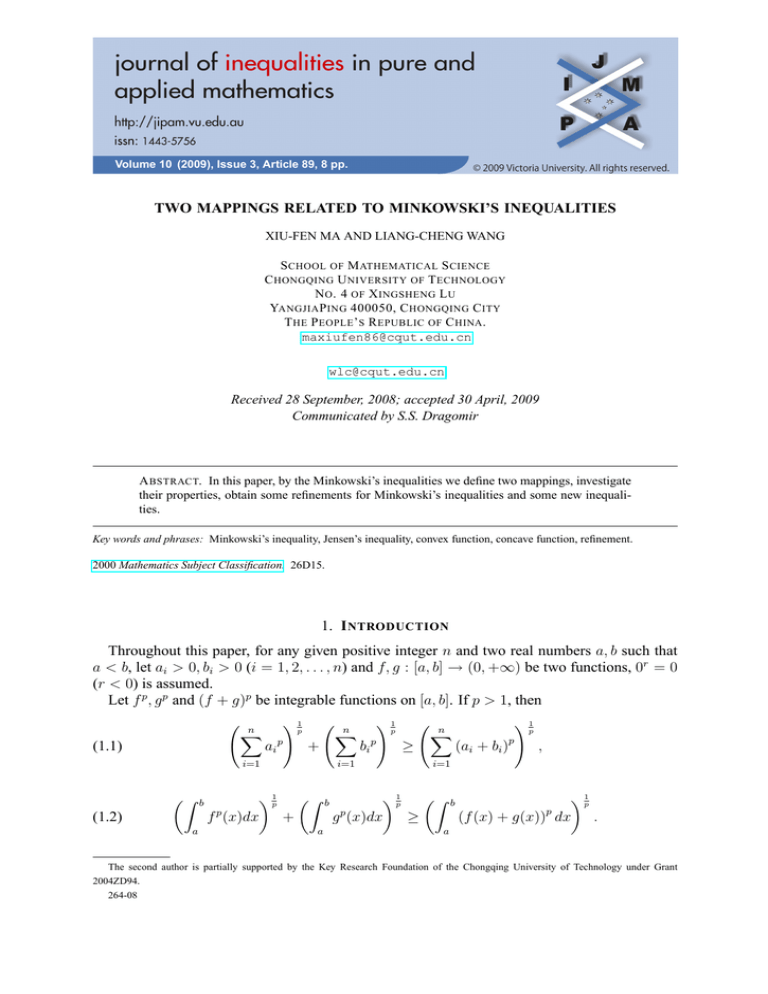
Volume 10 (2009), Issue 3, Article 89, 8 pp.
TWO MAPPINGS RELATED TO MINKOWSKI’S INEQUALITIES
XIU-FEN MA AND LIANG-CHENG WANG
S CHOOL OF M ATHEMATICAL S CIENCE
C HONGQING U NIVERSITY OF T ECHNOLOGY
N O . 4 OF X INGSHENG L U
YANGJIA P ING 400050, C HONGQING C ITY
T HE P EOPLE ’ S R EPUBLIC OF C HINA .
maxiufen86@cqut.edu.cn
wlc@cqut.edu.cn
Received 28 September, 2008; accepted 30 April, 2009
Communicated by S.S. Dragomir
A BSTRACT. In this paper, by the Minkowski’s inequalities we define two mappings, investigate
their properties, obtain some refinements for Minkowski’s inequalities and some new inequalities.
Key words and phrases: Minkowski’s inequality, Jensen’s inequality, convex function, concave function, refinement.
2000 Mathematics Subject Classification. 26D15.
1. I NTRODUCTION
Throughout this paper, for any given positive integer n and two real numbers a, b such that
a < b, let ai > 0, bi > 0 (i = 1, 2, . . . , n) and f, g : [a, b] → (0, +∞) be two functions, 0r = 0
(r < 0) is assumed.
Let f p , g p and (f + g)p be integrable functions on [a, b]. If p > 1, then
n
X
(1.1)
! p1
ai p
n
X
+
b
p
f (x)dx
(1.2)
a
bi p
≥
i=1
i=1
Z
! p1
p1
Z
+
b
p
g (x)dx
a
n
X
! p1
(ai + bi )p
,
i=1
p1
Z
≥
b
p
(f (x) + g(x)) dx
p1
.
a
The second author is partially supported by the Key Research Foundation of the Chongqing University of Technology under Grant
2004ZD94.
264-08
2
X IU -F EN M A AND L IANG -C HENG WANG
The inequalities (1.1) and (1.2) are equivalent to the following:
! p1
! p1
! p1 n
! 1q
n
n
n
X
X
X
X
p
p
(1.3)
ai p
+
bi p
−
(ai + bi )
(ai + bi )
i=1
i=1
n
X
=
i=1
! p1
ai
p
n
X
+
i=1
i=1
!1
p
bi
p
n
X
i=1
! 1q
p
(ai + bi )
i=1
−
n
X
(ai + bi )p ≥ 0
i=1
and
" Z
b
(1.4)
p1 Z b
p1 Z b
p1 #
f p (s)ds
+
g p (s)ds
−
(f (s) + g(s))p ds
a
a
a
b
Z
(f (s) + g(s))p ds
×
1q
a
p1
b
Z
p
=
f (s)ds
Z
+
a
b
p
p1 ! Z
g (s)ds
a
Z
−
b
1q
(f (s) + g(s)) ds
p
a
b
(f (s) + g(s))p ds
a
≥ 0,
respectively.
If p < 1 (p 6= 0), then the inequalities in (1.1), (1.2), (1.3) and (1.4) are reversed.
The inequality (1.1) is called the Minkowski inequality, (1.2) is the integral form of inequality
(1.1) (see [1] – [5]). For some recent results which generalize, improve, and extend this classic
inequality, see [6] and [7].
To go further into (1.1) and (1.2), we define two mappings M and m by
M : {(j, k) | 1 ≤ j ≤ k ≤ n; j, k ∈ N} → R,
! p1 k
! 1q
! p1
k
k
k
X
X
X
X
M (j, k) =
ai p
+
bi p
(ai + bi )p
−
(ai + bi )p ,
i=j
i=j
i=j
i=j
m : {(x, y) | a ≤ x ≤ y ≤ b} → R,
" Z
p1 # Z
p1 Z y
y
+
g p (s)ds
m(x, y) =
f p (s)ds
x
x
Z
−
y
p
1q
(f (s) + g(s)) ds
x
y
(f (s) + g(s))p ds,
x
where p and q be two non-zero real numbers such that p−1 + q −1 = 1.
M and m are generated by (1.3) and (1.4), respectively.
The aim of this paper is to study the properties of M and m, thus obtaining some new inequalities and refinements of (1.1) and (1.2).
2. M AIN R ESULTS
The properties of the mapping M are embodied in the following theorem.
J. Inequal. Pure and Appl. Math., 10(3) (2009), Art. 89, 8 pp.
http://jipam.vu.edu.au/
M APPINGS R ELATED TO M INKOWSKI ’ S I NEQUALITIES
3
Theorem 2.1. Let ai > 0, bi > 0 (i = 1, 2, . . . , n; n > 1), p and q be two non-zero real numbers
such that p−1 + q −1 = 1, and M be defined as in the first section. We write
! p1
! p1 k
! 1q
k
k
X
X
X
D(j, k) =
ai p
+
bi p
(ai + bi )p
i=j
i=j
i=j
#
j−1
n
X
X
(ai + bi )p
+
(ai + bi )p +
i=1
i=k+1
×
n
X
!− 1q
(ai + bi )p
,
(1 ≤ j ≤ k ≤ n) ,
i=1
P
p
where v−1
i=v (ai + bi ) = 0 (v = 1, n + 1).
When p > 1, we get the following three class results.
(1) For any three positive integers r, j and k such that 1 ≤ r ≤ j < k ≤ n, we have
M (r, k) ≥ M (r, j) + M (j + 1, k).
(2.1)
(2) For l, j = 1, 2, . . . , n − 1, we have
(2.2)
M (1, l + 1) ≥ M (1, l),
(2.3)
M (j, n) ≥ M (j + 1, n).
(3) For any two real numbers α ≥ 0 and β ≥ 0 such that α + β = 1, we get the following
refinements of (1.1)
! p1
! p1
n
n
X
X
ai p
(2.4)
+
bi p
= D(1, n)
i=1
i=1
≥ αD(1, n − 1) + βD(2, n)
≥ ···
≥ αD(1, 2) + βD(n − 1, n)
≥ αD(1, 1) + βD(n, n)
! p1
n
X
.
=
(ai + bi )p
i=1
When p < 1 (p 6= 0), the inequalities in (2.1) – (2.4) are reversed.
The properties of the mapping m are given in the following theorem.
Theorem 2.2. Let f p , g p and (f + g)p be integrable functions on [a, b], p and q be two non-zero
real numbers such that p−1 + q −1 = 1, and m be defined as in the first section. Then we obtain
the following four class results.
(1) If p > 1, for any x, y, z ∈ [a, b] such that x < y < z, then
(2.5)
m(x, z) ≥ m(x, y) + m(y, z).
If p < 1 (p 6= 0), then the inequality in (2.5) is reversed.
(2) The mapping m(x, b) monotonically decreases when p > 1, and monotonically increases for p < 1 (p 6= 0) on [a, b] with respect to x.
J. Inequal. Pure and Appl. Math., 10(3) (2009), Art. 89, 8 pp.
http://jipam.vu.edu.au/
4
X IU -F EN M A AND L IANG -C HENG WANG
(3) The mapping m(a, y) monotonically increases when p > 1, and monotonically decreases for p < 1 (p 6= 0) on [a, b] with respect to y.
(4) For any x ∈ (a, b) and any two real numbers α ≥ 0 and β ≥ 0 such that α + β = 1,
when p > 1, we get the following refinement of (1.2)
Z
b
(2.6)
a
f p (s)ds
" Z
p1
x
≥α
b
Z
g p (s)ds
+
p1
a
p1 Z
p
+
f (s)ds
a
p1 ! Z
x
p
g (s)ds
b
a
Z b
− 1q
p
(f (s) + g(s)) ds
(f (s) + g(s)) ds
x
a
" Z
b
f p (s)ds
+β
p1
Z
x
x
+
p
≥
x
Z
b
p
(f (s) + g(s)) ds
− 1q
(f (s) + g(s)) ds
a
b
p1 ! Z b
1q
g p (s)ds
(f (s) + g(s))p ds
b
+
x
Z
1q
p
+
Z
p
(f (s) + g(s)) ds
a
Z
x
a
p1
(f (s) + g(s)) ds .
p
a
If p < 1 (p 6= 0), then the inequalities in (2.6) are reversed.
3. S EVERAL L EMMAS
In order to prove the above theorems, we need the following two lemmas.
Lemma 3.1. Let ci > 0, di > 0 (i = 1, 2, . . . , n; n > 1), p and q be two non-zero real numbers
such that p−1 + q −1 = 1. We write
H(j, k; ci , di ) =
k
X
! p1
ci
p
i=j
k
X
! 1q
di
q
−
i=j
k
X
ci di ,
(1 ≤ j ≤ k ≤ n).
i=j
For any three positive integers r, j and k such that 1 ≤ r ≤ j < k ≤ n, if p > 1, we obtain
(3.1)
H(r, k; ci , di ) ≥ H(r, j; ci , di ) + H(j + 1, k; ci , di ).
The inequality in (3.1) is reversed for p < 1 (p 6= 0).
Proof of Lemma 3.1.
1
Case 1: p > 1. Clearly, 0 < p−1 < 1 and x p is a concave function on (0, +∞) with respect to
x. Using Jensen’s inequality for concave functions (see [2] – [4] and [8]) and p−1 + q −1 = 1,
J. Inequal. Pure and Appl. Math., 10(3) (2009), Art. 89, 8 pp.
http://jipam.vu.edu.au/
M APPINGS R ELATED TO M INKOWSKI ’ S I NEQUALITIES
5
for any three positive integers r, j and k such that 1 ≤ r ≤ j < k ≤ n, we have
(3.2)
H(r, k; ci , di )
! p1
k
X
ci p
=
k
X
i=r
=
k
X
! 1q
di
q
−
i=r
!
di q
k
X
!−1
di q
+
!
≥
X
di q
di
!−1
=
ci
i=r
di q
−
k
X
ci di
i=r
ci p
di q
i=j+1
di
q
k
X
+
i=r
X
ci
p
1
p
i=j+1
!−1
k
X
! 1q
k
X
ci di −
i=r
k
X
! p1
ci p −
i=j+1
! p1
ci
k
X
p
i=j+1
j
−
ci p
i=r
!
k
X
!
i=r
!
j
X
p
di q
j
X
! p1
X
di q
i=j+1
j
X
q
j
i=r
! p1
di
!−1
i=r
i=j+1
X
+
!−1
k
X
q
j
k
X
j
X
i=r
!
i=r
di q
i=j+1
j
!
j
X
i=r
k
X
ci di
i=r
i=r
k
X
k
X
ci di
i=r
! 1q
di q
i=j+1
ci di
i=j+1
= H(r, j; ci , di ) + H(j + 1, k; ci , di ),
which is (3.1).
1
Case 2: p < 1 (p 6= 0). Clearly, x p is a convex function on (0, +∞). Using Jensen’s inequality
for convex functions (see [2] – [4] and [8]), we obtain the reverse of (3.2), which is the reverse
of (3.1).
The proof of Lemma 3.1 is completed.
Lemma 3.2. Let p and q be two non-zero real numbers such that p−1 + q −1 = 1, and let up , v p
and (u + v)p be positive integrable functions on [a, b]. We write
Z
h(x, y; u, v) =
y
p
p1 Z
y
u (s)ds
x
1q Z
v (s)ds
−
y
q
x
u(s)v(s)ds,
(a ≤ x ≤ y ≤ b).
x
When p > 1, for any x, y, z ∈ [a, b] such that x < y < z, we obtain
(3.3)
h(x, z; u, v) ≥ h(x, y; u, v) + h(y, z; u, v).
When p < 1 (p 6= 0), the inequality in (3.3) is reversed.
1
Proof of Lemma 3.2. When p > 1, i. e. 0 < p−1 < 1, x p is a concave function on (0, +∞).
Using Jensen’s integral inequality for concave functions (see [2] – [4] and [8]) and p−1 + q −1 =
J. Inequal. Pure and Appl. Math., 10(3) (2009), Art. 89, 8 pp.
http://jipam.vu.edu.au/
6
X IU -F EN M A AND L IANG -C HENG WANG
1, for any x, y, z ∈ [a, b] such that x < y < z, we obtain
(3.4)
h(x, z; u, v)
" Z
Z z
=
v q (s)ds
x
−1
z
q
Z
q
−1 Z
v (s)ds
y
y
v q (s)ds
x
Z
y
v q (s)ds
Z
v q (s)ds
y
Z
−
=
x
−1 Z
−
u(s)v(s)ds
! p1
up (s)ds
y
z
! p1
up (s)ds
y
Z
z
u(s)v(s)ds
y
p1 Z
p
z
Z
x
−1 Z
q
v (s)ds
z
u(s)v(s)ds −
y
u (s)ds
y
y
x
Z
p
up (s)ds
x
z
+
z
y
x
!# p1
y
x
Z
−1 Z
v (s)ds
q
x
q
v (s)ds
y
Z
≥
z
y
v (s)ds
x
z
+
Z
q
v (s)ds
x
Z
y
Z
1q
y
q
Z
z
p
u (s)ds
v (s)ds
+
u (s)ds
x
y
Z y
Z z
−
u(s)v(s)ds −
u(s)v(s)ds
x
p1 Z
z
q
1q
v (s)ds
y
y
= h(x, y; u, v) + h(y, z; u, v),
which is (3.3).
1
When p < 1 (p 6= 0), x p is a convex function on (0, +∞). Using Jensen’s integral inequality
for convex functions (see [2] – [4] and [8]), we obtain the reverse of (3.4), which is the reverse
of (3.3).
The proof of Lemma 3.2 is completed.
4. P ROOF OF THE T HEOREMS
Proof of Theorem 2.1. From p−1 + q −1 = 1 (i. e. p = q(p − 1)) and definitions of M and H,
we get
(4.1)
M (j, k) = H j, k; ai , (ai + bi )p−1 + H j, k; bi , (ai + bi )p−1 .
Case 1: p > 1.
(1) For any three positive integers r, j and k such that 1 ≤ r ≤ j < k ≤ n, from (4.1) and
(3.1), we obtain
(4.2)
M (r, k) = H r, k; ai , (ai + bi )p−1 + H r, k; bi , (ai + bi )p−1
≥ H r, j; ai , (ai + bi )p−1 + H r, j; bi , (ai + bi )p−1
+ H j + 1, k; ai , (ai + bi )p−1 + H j + 1, k; bi , (ai + bi )p−1
= M (r, j) + M (j + 1, k),
which is (2.1).
(2) For l = 1, 2, . . . , n − 1, replacing r, j and k in (2.1) with 1, l and l + 1, respectively,
then (2.1) reduces to (2.2) (because M (l + 1, l + 1) = 0). For j = 1, 2, . . . , n − 1,
J. Inequal. Pure and Appl. Math., 10(3) (2009), Art. 89, 8 pp.
http://jipam.vu.edu.au/
M APPINGS R ELATED TO M INKOWSKI ’ S I NEQUALITIES
7
replacing r and k in (2.1) with j and n, respectively, then (2.1) reduces to (2.3) (because
M (j, j) = 0).
(3) From the definitions of D and M , we have
"
# n
!− 1q
n
X
X
(4.3)
D(j, k) = M (j, k) +
.
(ai + bi )p
(ai + bi )p
i=1
i=1
Using (4.3), from α ≥ 0, β ≥ 0, (2.2) and (2.3), we get
αD(1, n) ≥ αD(1, n − 1) ≥ · · · ≥ αD(1, 2) ≥ αD(1, 1)
(4.4)
and
(4.5)
βD(1, n) ≥ βD(2, n) ≥ · · · ≥ βD(n − 1, n) ≥ βD(n, n),
respectively. From α + β = 1, expression (4.4) combined with (4.5) yields (2.4).
Case 2: p < 1 (p 6= 0). The reverse of (3.1) implies the reverse of (4.2). Further, the reverse
of (4.2) implies the reverse of (2.1), (2.2) and (2.3). The reverse of (2.2) and (2.3) implies the
reverse of (4.4) and (4.5), respectively. The reverse of (4.4) combined with the reverse of (4.5)
yields the reverse of (2.4).
The proof of Theorem 2.1 is completed.
Proof of Theorem 2.2. From p−1 + q −1 = 1 (i. e. p = q(p − 1)) and the definitions of m and h,
we get
(4.6)
m(x, y) = h x, y; f, (f + g)p−1 + h x, y; g, (f + g)p−1 .
(1) If p > 1, for any x, y, z ∈ [a, b] such that x < y < z, from (4.6) and (3.3), we get
(4.7)
m(x, z) = h(x, z; f, (f + g)p−1 ) + h(x, z; g, (f + g)p−1 )
≥ h(x, y; f, (f + g)p−1 ) + h(x, y; g, (f + g)p−1 )
+ h(y, z; f, (f + g)p−1 ) + h(y, z; g, (f + g)p−1 )
= m(x, y) + m(y, z),
which is (2.5).
If p < 1 (p 6= 0), then the reverse of (3.3) implies the reverse of (4.7). Further, (2.5)
is reversed.
(2) When p > 1, for any x1 , x2 ∈ [a, b], x1 < x2 , if x2 < b, taking z = b, x = x1 and
y = x2 in (2.5) and using m(x1 , x2 ) ≥ 0, we obtain
(4.8)
m(x1 , b) ≥ m(x1 , x2 ) + m(x2 , b) ≥ m(x2 , b).
If x2 = b, by the definition of m we have
(4.9)
m(x1 , b) ≥ 0 = m(b, b) = m(x2 , b).
Then (4.8) and (4.9) imply that m(x, b) is monotonically decreasing on [a, b].
When p < 1 (p 6= 0), then the inequality in (2.5) is reversed, m(x, y) ≤ 0 and
m(x, b) ≤ 0. Further, the inequalities in (4.8) and (4.9) are reversed, which implies that
m(x, b) is monotonically increasing on [a, b].
(3) Using the same method as that for the proof of the monotonicity of m(x, b), we can
prove the monotonicity of m(a, y) on [a, b] with respect to y.
J. Inequal. Pure and Appl. Math., 10(3) (2009), Art. 89, 8 pp.
http://jipam.vu.edu.au/
8
X IU -F EN M A AND L IANG -C HENG WANG
(4) Case 1: p > 1. For any x ∈ (a, b), from the increasing property of m(a, y) on [a, b]
with respect to y, m(a, a) = 0 and α ≥ 0, we get
Z b
− 1q
Z b
p
p
(4.10)
α m(a, b) +
(f (s) + g(s)) ds
(f (s) + g(s)) ds
a
a
Z b
− 1q
Z b
≥ α m(a, x) +
(f (s) + g(s))p ds
(f (s) + g(s))p ds
a
a
Z b
− 1q
Z b
p
p
≥ α m(a, a) +
(f (s) + g(s)) ds
(f (s) + g(s)) ds
.
a
a
From the decreasing property of m(x, b) on [a, b] with respect to x, m(b, b) = 0 and
β ≥ 0, we get
Z b
− 1q
Z b
p
p
(4.11)
β m(a, b) +
(f (s) + g(s)) ds
(f (s) + g(s)) ds
a
a
Z b
− 1q
Z b
≥ β m(x, b) +
(f (s) + g(s))p ds
(f (s) + g(s))p ds
a
a
Z b
− 1q
Z b
p
p
≥ β m(b, b) +
(f (s) + g(s)) ds
(f (s) + g(s)) ds
.
a
a
From α + β = 1, expression (4.10) plus (4.11), with a simple manipulation, we obtain
(2.6).
Case 2: p < 1 (p 6= 0). The decreasing property of m(a, y) on [a, b] with respect to y
and the increasing property of m(x, b) on [a, b] with respect to x imply the reverse of
(4.10) and (4.11), respectively. The reverse of (4.10) and (4.11) yields the reverse of
(2.6).
The proof of Theorem 2.2 is completed.
R EFERENCES
[1] K. SHEBRAWI AND H. ALBADAWI, Operator norm inequalities of Minkowski type, J. Inequal.
Pure Appl. Math., 9(1) (2008), Art. 26. [ONLINE: http://jipam.vu.edu.au/article.
php?sid=944]
[2] D.E. DAYKIN AND C.J. ELIEZER, Generalization of Hölder’s and Minkowski’s inequalities, Proc.
Cambridge Phil. Soc., 64 (1968), 1023–1027.
[3] E.F. BECKENBACH
1965.
AND
R. BELLMAN, Inequalities (2nd ed.), Berlin-Heidelberg-New York,
[4] N.I. ACHIESER, Vorlesungen über Approximationstheorie, Berlin, 1953.
[5] L.C. WANG, Convex Functions and Their Inequalities, Sichuan University Press, Chengdu, China,
2001. (Chinese).
[6] D.S. MITRINOVIĆ, Analytic Inequalities, Springer-Verlag, Berlin, 1970.
[7] J.C. KUANG, Applied Inequalities, Shandong Science and Technology Press, Jinan, China, 2004.
(Chinese).
[8] L.C. WANG, Two mappings related to Hölder’s inequality, Univ. Beograd. Publ. Elektrotehn. Fak.
Ser. Mat., 15 (2004), 92–97.
J. Inequal. Pure and Appl. Math., 10(3) (2009), Art. 89, 8 pp.
http://jipam.vu.edu.au/
